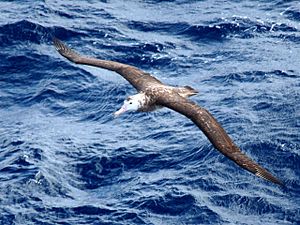Tristan albatross facts for kids
Quick facts for kids Tristan albatross |
|
|---|---|
 |
|
| Conservation status | |
| Scientific classification | |
| Genus: |
Diomedea
|
| Species: |
dabbenena
|
| Synonyms | |
|
Diomedea exulans dabbenena(Mathews, 1929) |
|
The Tristan albatross (Diomedea dabbenena) is a very large seabird. It belongs to the albatross family. This amazing bird is one of the "great albatrosses." Scientists officially recognized it as its own species in 1998.
Contents
Understanding the Tristan Albatross Family
Albatrosses are part of a bird group called Procellariiformes. This group also includes birds like shearwaters and petrels. All these birds share some special features. For example, they have unique nose tubes on their upper beaks. These are called naricorns. Albatross nostrils are on the sides of their beaks.
Their beaks are also special. They are made of 7 to 9 hard plates. Albatrosses can also make a special stomach oil. This oil is stored in their stomach. They use it to protect themselves from predators. It is also a super-rich food source for their chicks. Adults use it for energy during their very long flights.
How Scientists Identify Species
Not all scientists agree that the Tristan albatross is a full species. Some still think it is a type of wandering albatross. However, a study in 2004 looked at the DNA of these birds. This study supported the idea that it is a separate species. Other research shows it is very different genetically. This might be because it split off from its relatives a long time ago. It could also be due to strong genetic drift.
Many bird experts now see it as a distinct species. For example, BirdLife International has recognized it as a separate species.
What's in a Name? The Diomedea Story
The name Diomedea comes from an old Greek story. It refers to a hero named Diomedes. The story says that his friends were turned into birds.
What Does the Tristan Albatross Look Like?
It is very hard to tell the Tristan albatross apart from the wandering albatross at sea. The Tristan albatross is a bit smaller. It also has a slightly darker back. This bird is about 110 centimeters (43 inches) long. Its wings can spread up to 3.05 meters (10 feet) wide.
The Tristan albatross never gets completely white feathers. The wandering albatross can become fully white. The Tristan albatross's beak is also about 25 millimeters (1 inch) shorter.
Tristan Albatross Behavior and Reproduction
The Tristan albatross eats mostly fish. It also feeds on cephalopods, like squid.
These birds breed every two years. They build their nests in wet, grassy areas. They prefer places that are 400 to 700 meters (1,300 to 2,300 feet) high. Tristan albatrosses are monogamous. This means they have only one partner for life. They do not start breeding until they are about 10 years old.
Where Do Tristan Albatrosses Live?
It is hard to know exactly where they fly at sea. This is because they look so much like wandering albatrosses. But scientists use satellite tracking to follow them. This shows they fly widely in the South Atlantic. Males often fly west of their breeding islands, towards South America. Females fly east, towards Africa. They have even been seen near Brazil and off the coast of Australia.
Tristan albatrosses live only on the islands of the Tristan da Cunha group. Most of them nest on Gough Island. About 1,500 pairs live there. Sometimes, a pair will breed on Inaccessible Island.
Protecting the Tristan Albatross
In the past, these birds were threatened by animals brought to the islands. These included rats, cats, and pigs. But these animals have now been removed from the breeding islands. However, this led to a new problem. The number of mice grew a lot. These mice started eating and killing albatross chicks. Even though the chicks are huge, they do not know how to defend themselves.
Today, the biggest threats are long-line fishing and these mice. Recent counts show that the population on Gough has dropped by 28% in 46 years. Scientists predict even faster declines.
The Tristan albatross was once listed as an endangered species. But experts realized it was in more danger than thought. In 2008, its status was changed. It is now listed as Critically Endangered. This means it faces a very high risk of becoming extinct in the wild. They have a huge flying range of 14,000,000 square kilometers (5,400,000 square miles). But their breeding area is very small, only 80 square kilometers (31 square miles).
See also
 In Spanish: Albatros de Tristán para niños
In Spanish: Albatros de Tristán para niños


